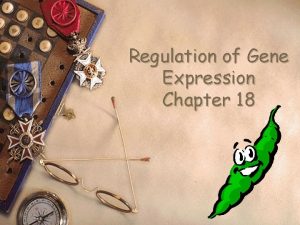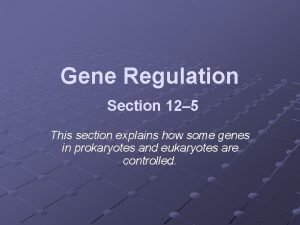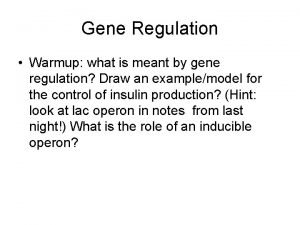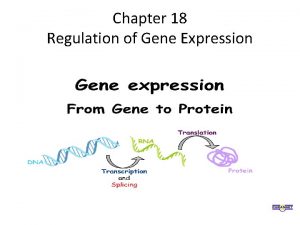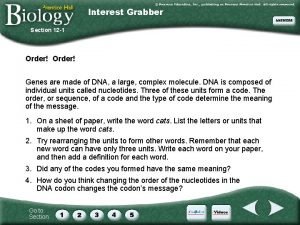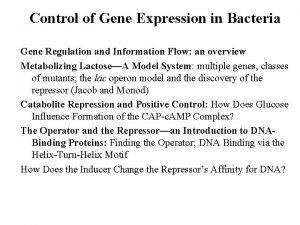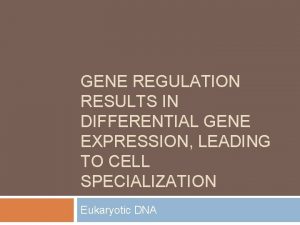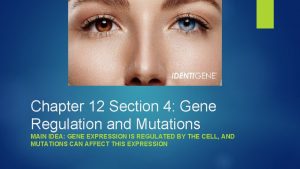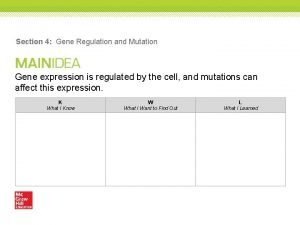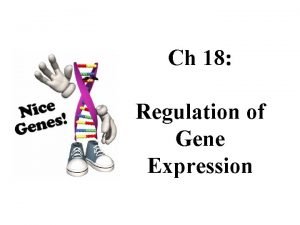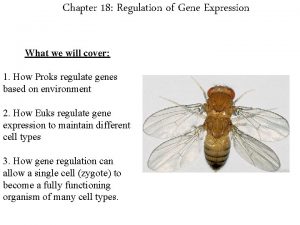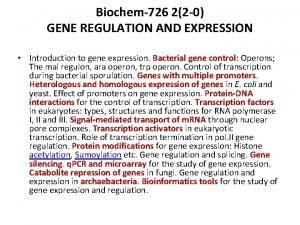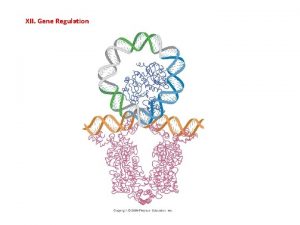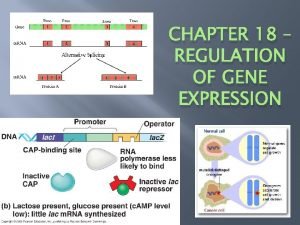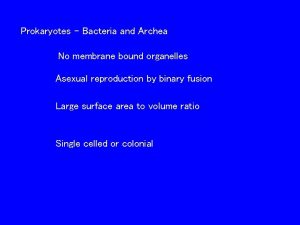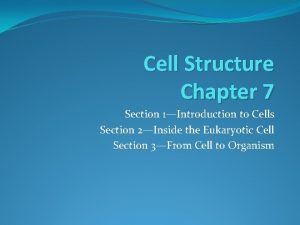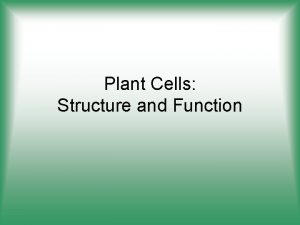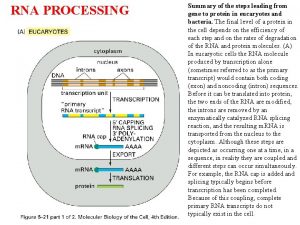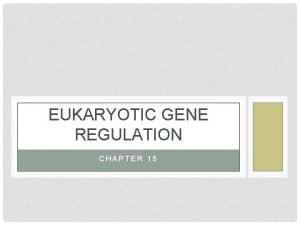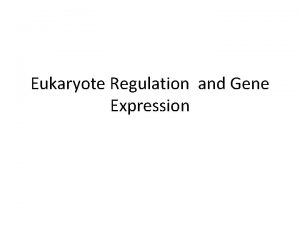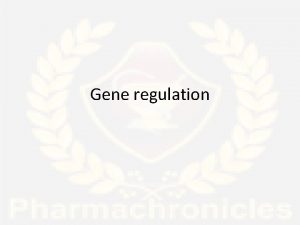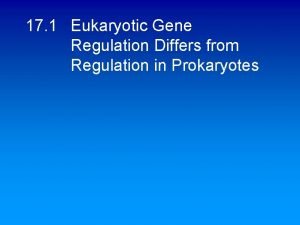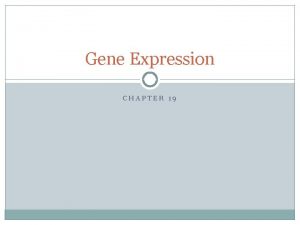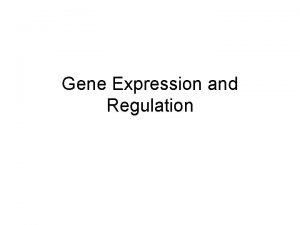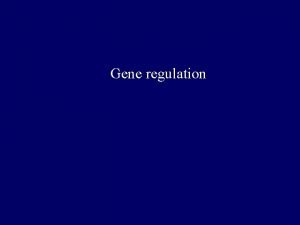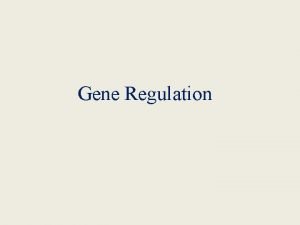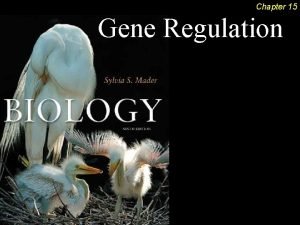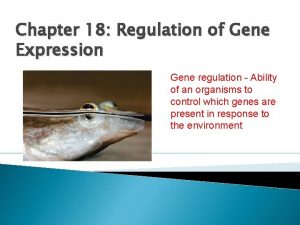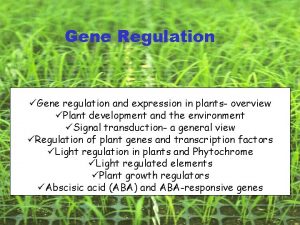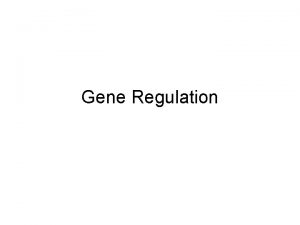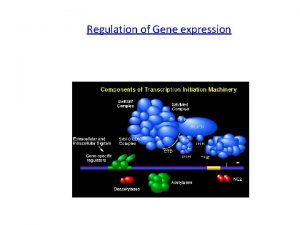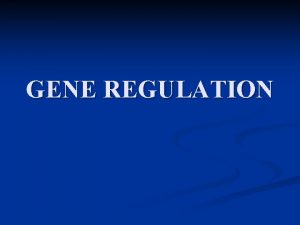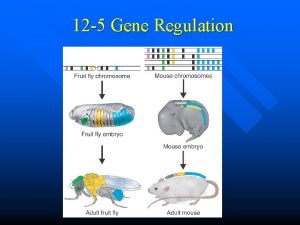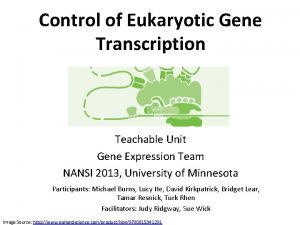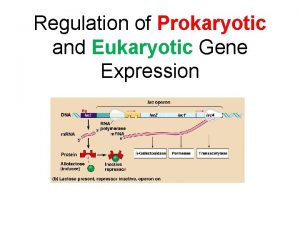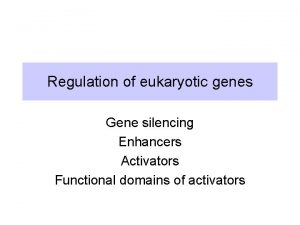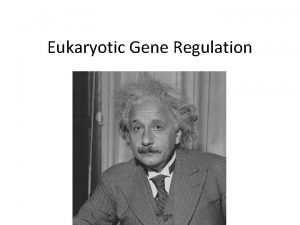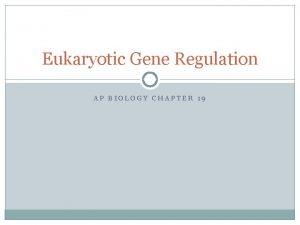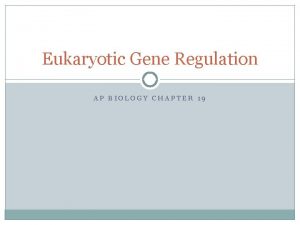Eukaryotic Gene Regulation April 24 2015 Richard D




























- Slides: 28

Eukaryotic Gene Regulation April 24, 2015 Richard D. Howells, Ph. D MSB E-643 howells@njms. rutgers. edu 1

Objectives During this presentation you may v. Catch another 40 winks, or v. Understand key concepts regarding regulation of gene expression in eukaryotes 2

Gene organization in prokaryotes and eukaryotes 3

From Molecular Cell Biology, 7 th ed. , Lodish et al. , 2012 4

Column chromatography separates and identifies the three eukaryotic RNA polymerases, each with its own sensitivity to a-amanitin. 5

Amanita phalloides: the Death Cap The poisonous mushroom, Amanita phalloides, contains -amanitin, a cyclic octapeptide that blocks elongation by RNA Pol II. It is lethal at 10 n. M. The initial reaction to ingestion of the mushroom is gastrointestinal distress, and 48 h later the subject 6 dies, usually from liver dysfunction.

7

Transcription of the r. RNA precursor RNA by RNA polymerase I 5. 8 S r. RNA 8

Transcription-control elements in genes transcribed by RNA polymerase III 9

Changes that occur during the processing of tyrosine pre-t. RNA. 10

Pol II preinitiation complex 11 11

RNA Pol II Preinitiation Complex 12

General organization of control elements that regulate gene expression in multicellular eukaryotes and yeast 13

Model of several DNA-bound activators interacting with a single mediator complex (Purple- TBP, Red- TFIIB, Blue- TFIIH, Green- TFIIE) 14 14

Regulation of gene expression via post-translational modification of histone side chains Lysine Acetylated Lysine HAT: histone acetyltransferase activity HDAC: histone deacetylase activity 15

Heterochromatin versus euchromatin 16

Hormones that bind specific receptors that are stimulated to become ligand-activated transcription factors These and related lipid-soluble hormones bind to receptors located in the nucleus and cytoplasm. The hormone-receptor complex functions as a transcription factor in the nucleus. 17

Fusion proteins from expression vectors demonstrate that the hormone-binding domain of the glucocorticoid receptor (GR) mediates translocation to the nucleus in the presence of hormone 18 AD: activation domain; DBD: DNA binding domain; LBD: ligand binding domain

Zinc-finger domain 19

Activation of gene expression via elevated c. AMP and phosphorylation of CREB CRE: c. AMP response element; CREB: CRE binding protein; CBP: CREB binding protein 20

Mutation of CBP causes pleiotropic developmental abnormalities: Rubinstein-Taybi syndrome 21

Overview of m. RNA processing in eukaryotes 22

Synthesis of 5’-cap on eukaryotic m. RNAs (N refers to the nucleotide at the 5’-end of the pre-m. RNA transcript) 23

Structure of the 5’methylated cap of eukaryotic m. RNA 24

Model for cleavage and polyadenylation of prem. RNAs in mammalian cells CPSF- cleavage and polyadenylation specificity factor CSt. F- cleavage stimulatory factor CFI, CFII- cleavage factors PAP- poly(A) polymerase PABP II- poly(A) binding protein II protein 25 25

Model of spliceosomemediated splicing of prem. RNA 26

Base pairing with target RNAs distinguishes mi. RNA and si. RNA 27

Overview of RNA processing and posttranscriptional gene control 28
 Chapter 18 regulation of gene expression
Chapter 18 regulation of gene expression Eukaryotic promoters are usually found just
Eukaryotic promoters are usually found just Gene regulation
Gene regulation Chapter 18 regulation of gene expression
Chapter 18 regulation of gene expression Section 12-5 gene regulation answer key
Section 12-5 gene regulation answer key Regulation of gene expression
Regulation of gene expression Positive vs negative gene regulation
Positive vs negative gene regulation Differential gene regulation
Differential gene regulation Chapter 12 section 4 gene regulation and mutations
Chapter 12 section 4 gene regulation and mutations Section 4 gene regulation and mutations
Section 4 gene regulation and mutations Chapter 18 regulation of gene expression
Chapter 18 regulation of gene expression Chapter 18 regulation of gene expression
Chapter 18 regulation of gene expression Regulation of gene expression
Regulation of gene expression Gene expression in prokaryotes and eukaryotes
Gene expression in prokaryotes and eukaryotes What is gene regulation
What is gene regulation Prokaryotes vs eukaryotes gene regulation
Prokaryotes vs eukaryotes gene regulation Gene by gene test results
Gene by gene test results Protein power point
Protein power point King richard iii and looking for richard
King richard iii and looking for richard Similarities between prokaryotic and eukaryotic cells
Similarities between prokaryotic and eukaryotic cells Biology chapter 7 cell structure and function
Biology chapter 7 cell structure and function Are bacteria prokaryotic or eukaryotic
Are bacteria prokaryotic or eukaryotic Flower sepal
Flower sepal Parenchymatous algae
Parenchymatous algae Sporozoa
Sporozoa Food vacuole eukaryotic or prokaryotic
Food vacuole eukaryotic or prokaryotic Typical plant cell
Typical plant cell Eukaryotic splicing
Eukaryotic splicing Prokaryotic cells
Prokaryotic cells
